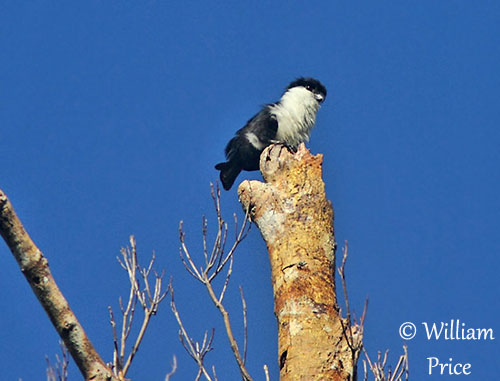
Male and female are very similar, although the female has all-black underwing, with no barring on flight-feathers. She is slightly larger than male (5 to 20%).
The juvenile resembles adult but it shows a bright tawny-yellow wash on the ear-coverts.
RANGE:
The Philippine Falconet is endemic to the Philippines Islands and occurs on several islands including Luzon, Catanduanes, Mindoro, Panay, Negros, Cebu, Bohol, Samar, Leyte, Calicoan and Mindanao.
HABITAT:
The Philippine Falconet frequents open wet forest, clearings and edges, often near streams and rivers. This species occurs from lowlands to montane forests, usually between 300 and 1,200 metres of elevation, but it is also recorded at sea-level.
CALLS AND SONGS: SOUNDS BY XENO-CANTO
The Philippine Falconet gives a rapid, high-pitched “chik-chik-erk-erk” and a continuous, squeaky “pew pew pew pew” with about two notes per second.
BEHAVIOUR IN THE WILD:
The Philippine Falconet feeds mainly on insects including Odonata and Lepidoptera species. Some lizards can be taken on trees or sometimes on the ground.
It hunts from perch near streams and clearings. Once a prey is detected, it dashes out to snatch it up in the bill. Then, the prey is carried back to the same perch where it is eaten.
This species may occasionally feed upside down on wasp nests, and it may also catch small birds in the air, in trees or on the ground.
The Philippine Falconet may sometimes forage in groups, probably family parties. Up to six individuals may hunt together. This small falcon spends most time perched in canopy or in upper branches of dead trees from which it hunts.
The communal hunting is probably a kind of
protection against predators, especially when larger falcons are approaching.
The Philippine Falconet uses old woodpecker or barbet holes for nesting. The breeding behaviour is poorly known, and no aerial displays have been described. They are suspected to remain in family group until the nest breeding season.
The Philippine Falconet is sedentary.
In flight, this species has compact body with pointed wings and square-ended tail. The flight action is similar to other falconet species, fast and direct, with rapid wingbeats interspersed with long glides. However, short flights are performed when it pursues a prey on the wing.
REPRODUCTION OF THIS SPECIES:
The breeding season occurs between February/March and May.
The Philippine Falconet nests in natural cavities, and regularly uses abandoned woodpecker hole in dead tree, from 6 to 10 metres above the ground, sometimes higher, up to 15 metres. It does not add nest material, except for some insect remains.
The size of the clutch is unknown, but from some observations, 3-4 fledglings can be reared.
The nest is usually strongly defended by both adults. The family parties stay together until the nest breeding season.
PROTECTION / THREATS / STATUS:
The Philippine Falconet is described as common to fairly common within its forest habitat. This species is not globally threatened for the moment, but intensive deforestation may become a problem in some regions.
The population is estimated to number 1,000/10,000 individuals, equating roughly to 670/6,700 mature individuals. It is suspected to be declining due to habitat destruction.
But currently, the Philippine Falconet is evaluated as Least Concern.
Fr: Fauconnet des Philippines
Ang: Philippine Falconet
All: Zweifarbenfälkchen
Esp: Falconete Filipino
Ita: Falchetto delle Filippine
Nd: Filipijnse Dwergvalk
Sd: filippinsk pygméfalk
Photographer:
William Price
PBase-tereksandpiper & Flickr William Price
Text by Nicole Bouglouan
Sources:
HANDBOOK OF THE BIRDS OF THE WORLD Vol 2 by Josep del Hoyo-Andrew Elliot-Jordi Sargatal - Lynx Edicions - ISBN: 8487334156
A Guide to the Birds of the Philippines De Robert Kennedy, Pedro C. Gonzales, Edward Dickinson, Hector C. Miranda, Jr, Timothy H. Fisher – Editeur: OUP Oxford, 2000 – ISBN: 0198546688, 9780198546689 - 169 pages
A manual of Philippine birds De R.C. McGregor – Editeur : Рипол Классик, 1909 – ISBN: 5877082183, 9785877082182 – 769 pages
Hawks De Tom Warhol – Editeur: Marshall Cavendish, 2005 – ISBN: 0761417443, 9780761417446 – 112 pages
RAPTORS OF THE WORLD by James Ferguson-Lees et David Christie - Helm Identification Guides – ISBN: 0713680261
Global Raptor Information Network - Working to Conserve Birds of Prey in nature
Wikipedia, the free encyclopaedia
Philippine Falconet
Microhierax erythrogenys
Falconiformes Order – Falconidae Family
INTRODUCTION:
The falconets of genus Microhierax are found in Southeast Asia. They are the smallest members of the Family Falconidae.
The Philippine Falconet is endemic to the Philippines where it can be seen perched on exposed branches from which it hunts and hawks flying insects. It frequents open wet forest including edges and clearing near streams. This species usually nests in abandoned woodpeckers holes.
The Philippine Falconet is described as common or fairly common within suitable forest habitat, but the population is decreasing due to habitat destruction. However, the species is not globally threatened for the moment.
DESCRIPTION OF THE BIRD:
Biometrics:
Length: 15-18 cm
Wingspan: 32-37 cm
Weight: 37-52 g
The Philippine Falconet has uniformly black upperparts from head to tail.
The underparts are white from lower cheeks to belly. Flanks and thighs are black, whereas the belly is sometimes washed buff. The underwing-coverts are black, and the flight-feathers are inconspicuously barred white.
On the head, forehead, crown and nape are black, whereas lower cheeks to ear-coverts are white.
The bill is blackish with dark grey cere. The eyes are dark brown. Legs and feet are dark grey to black.
